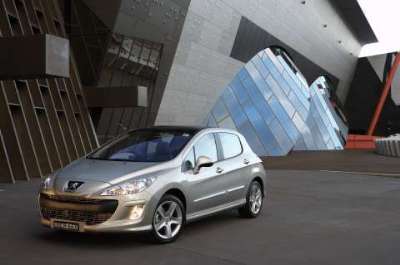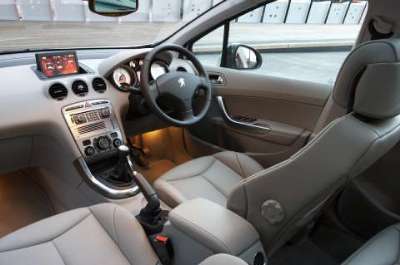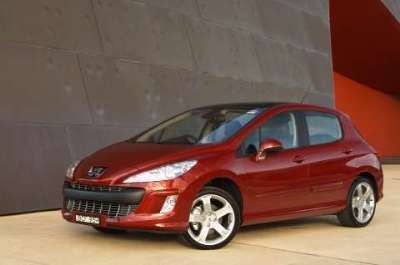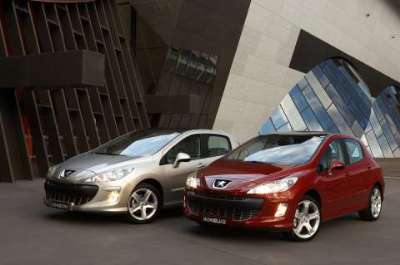|
| |||||
|
All-New Peugeot 308 Released Locally
7th March, 2008 | ||||
|
The new “3” series 'family' is Peugeot’s first vehicle of the “8” generation. The Peugeot 308 five-door hatchback is the first of the new 308 models to be launched, with the local release presently underway. Designed by Peugeot’s in-house teams, the Peugeot 308 builds on the successful concept of the Peugeot 307, with its semi-high architecture, large interior space, class leading safety equipment and high standards of road holding. The stylish design not only looks good but contributes to reducing fuel consumption and emissions, due to its class leading aerodynamics – Cx of 0.29 – enabling the 1.6 litre XS HDi model to emit only 130 g/km of CO2. The Peugeot 308 will be available in a comprehensive range of models: Petrol engines
HDi Diesel engines (all turbo-charged and fitted with particulate filter as standard)
Safety is another strength of the new Peugeot 308, as evidenced by the awarding of a 5-star crash protection rating by EuroNCAP. All 308’s have six airbags fitted as standard; and a seventh driver steering column or ‘knee’ airbag is available as an option on the XSE and XTE models. ESP is also standard on XSE and XTE models, available as an option on XS versions. The car has already been successfully launched in Europe, gaining rapid market acceptance and has been praised for its build quality and level of finish. Even though the car was only launched overseas in the last quarter of 2007, over 100,000 cars were produced by year’s end. Illustrating the success of the new model, the 308 was awarded the 2007 Goldene Lenkrad (Golden Steering Wheel) in Berlin. This prestigious honour has been awarded annually since 1976 by Germany’s national weekly newspaper Bild am Sonntag. All new models launched on the German market over the prior twelve months, were first divided into four main categories (small cars, compact, medium/executive and SUVs). Then they were short-listed by the readers of Bild am Sonntag. The jury consisted of racing drivers, automotive professionals and others. The next stage was to choose from the five finalists, the vehicle which went furthest in meeting a number of key criteria after a series of in depth trials and tests. These criteria included, style, design, comfort, road holding, safety, environmental friendliness and quality. The 308 hatchback, which went on sale on the German market for the first time on 15th September 2007, was chosen as the best compact family car, ahead of its four short-listed competitors. 
Peugeot’s new offering in the medium car segment, the 308, will be the first Peugeot car of the new “8” generation. It will be available in Australia in three trim levels: XS, XSE and XTE and powered by four engine options. It will initially replace the Peugeot 307 hatchback range with the introduction of the five door model. The Touring model will be released in Australia in mid-2008. As the replacement for the 307, it was only fitting that this new model should also continue the semi-tall architecture concept which first appeared with the introduction of the 307 in 2001. This design concept provides greater interior space, visibility, interior brightness and compact packaging. All strengths which have made the 307 a worldwide success with over three million sales. The 308, therefore, builds on the many strengths of the 307 but develops them even further in order to meet the high standards set for the project: an assertive style, comprehensive specification and high levels of quality, both perceived quality and “quality feel”. An exterior style more feline than ever The 308 embodies in its own way the characteristic Peugeot genes that give all of the marque’s models their strong identity. It strengthens, further, the obvious feline look and will be available with two different designs of the front: a classic look for the 308 XS models; the other a more dynamic design, for the XSE and XTE models. The design of the rear of the 308 also helps to identify it. The large wrap around lower bumper, available in two different styles, the more classical look for XS and XSE models and a “Sports” look for the XTE, which is also combined with a rear diffuser and the large rear lights emphasise the increased width of the vehicle and the large curved rear tailgate glass. 
A new and original interior The completely new design of the interior is perfectly in keeping with the exterior styling. The inclined design of the fascia panel helps to accentuate the feeling of space. Its flowing and elegant design coupled with the use of high quality materials (both to look at and to touch) provides an impression of quality seldom encountered in models in this market segment. The use of large expanses of glass combined with a panoramic glass roof (as standard on XTE versions or as an option on the XSE versions) provides a bright interior conducive to user-friendliness and the well-being of all occupants. Rear passengers will also be particularly at ease in the 308, thanks to its generous interior space resulting from its chosen architecture and the specially designed front seats. Dynamic efficiency The chassis and suspension of the 308, combined with the excellent body rigidity, have been meticulously developed to obtain the best possible combination between road holding and comfort. In addition, a wide front and rear track and larger tyres (up to 18" on the XTE version) ensure both excellent road holding and handling. Environmental impact The search to lessen the environmental impact of the vehicle was a key objective in all stages of development of the 308. Whether it was with regards to recycling, aerodynamics, its petrol and diesel engines, the use of an additive-based diesel particle filter system on the HDi diesel versions, the larger wheels and suspension (including electro-hydraulic power steering), reducing weight (involving the use of composite materials, aluminium and high-strength steel), everything has been carefully studied to optimise fuel consumption and reduce CO2 emissions. Indeed, the 308 powered by the 1.6 litre HDi 80 kW diesel engine produces only 130 g/km of CO2. A wide range of modern, high-performance engines At launch, the 308 will be available with four engine options to meet the requirements of the broadest possible customer base: two petrol engines and two HDi diesel engines. All petrol versions of the 308 feature the most recent engines developed jointly by the PSA Peugeot Citroën group and the BMW Group:
The 308 HDi offer consists of engines all featuring HDi direct injection technology:
Safety The objective to provide exemplary road holding forms the basis of the 308’s primary safety. At the level of secondary safety, the structure (particularly through the use of three impact absorption structures at the front) and its overall rigidity and ability to deform in a controlled manner, provides optimal impact protection. In addition, all 308 models have a minimum of six airbags as standard (seven airbags as an option on XSE and XTE versions – steering column airbag). 
Model Range The 308 model range consists of three trim levels. The standard specification of the XS model includes:
XSE model Added standard equipment:
XTE model Added standard equipment:
Exterior colours With 12 exterior body colours, different choices of interior ambience, cloth or leather trim (black or beige), the 308 knows very well how to play the “exclusive” card to appeal to a wide range of customers. Solid colours: Bianca White and Hurricane Grey.
The Market In 1934, the Peugeot range consisted of just five individual models: The top-of-the-range 601, the 401 (upper medium segment), the 201 in the most popular segment and the 301. Most of the models were also available in different body styles (saloon, two door versions, open-top coupé, etc). With the introduction of the 3 series, Peugeot entered the compact vehicle market segment, which has grown steadily over recent decades. In 2007, some 232,388 small segment vehicles were sold in the Australia, 36.5% of the total passenger car market. The segment has continued to grow, with increasing numbers of consumers looking to down-size to more economical and practical vehicles. Sales Objectives for the Peugeot 308 The Peugeot 308 replaces one of Peugeot’s most successful models in Australia, the 307. In 2007, a total of 4,119 307’s were sold; 2,312 hatches and 1,807 Tourings. In 2008, approximately 3,650 308’s are expected to be sold, along with 1,100 307’s for a total of 4,750 units in this segment. The 307 figure is composed of hatch sales in early 2008, and Touring models which continue until mid-year. The total will reflect an increase of 16% over the 2007 sales of the 3-series model. It is expected that 64% of 308 sales will be diesel versions. The Target Customer Young professionals looking for a dynamic, expressive and modern vehicle, older people in search of versatility, couples without children, young families: whether coming from the next range down or the next range up, customers in this segment are today particularly diversified. This segment offers many different choices and numerous benefits, be it in terms of value for money, vehicle size and interior space. Indeed, the latter is of particular importance in explaining the success of the 307. The Peugeot 307 Launched in 2001, the 307 stood out completely from other hatchbacks in its segment thanks to its semi-tall architecture. Taking on board the expected demands of future customers, Peugeot took the innovative risk of launching a hatchback vehicle with a very forward-positioned front windscreen and unusually tall architecture for the time. The result was a vehicle which offered generous interior space, excellent visibility and a bright welcoming interior for all its occupants.
Benefiting also from a resolutely elegant style, impeccably dynamic road holding and particularly innovative equipment for its segment, the 307, thanks to its excellent versatility, has already sold worldwide more than 3 million during the six years since its launch, a record figure for the marque in the compact vehicle segment. The 307 has therefore clearly left its mark; its concept, now an essential part of the motoring landscape, was naturally the basis for the conception of the 308. 307 – 308 Five Door Model Comparison Summary 307 - 308 (variance) The New Peugeot 308 in Detail Conception From the outset, the aim of the project was to ensure the 308 featured all of the strong points upon which the success of the 307 was built, but also develop them even further. The experiences gained with the 307 and its architecture and the technological advances made by the marque, have made it possible to succeed with this challenge and ensure also that the quality objectives for the project could also be met. As a result, the project named “T7” was built around the 307 platform and its semi-tall architecture. It was on this basis that all design studies were carried out and that the teams in the Styling, Engineering and Marketing departments worked together to design the new 308. The design team was headed up by British designer Keith Ryder who is Peugeot’s Design Director for Production Cars and heads up a multi-national team at Peugeot’s ADN design centre in Velizy, Paris. Exterior styling The project started back in 2003 when a number of “mock-ups” were built and used to illustrate a number of ideas. From the end of that year, in the Peugeot design studio which was still based at the La Garenne Centre in Paris, the T7 project also ran alongside that of the 907 concept car first shown at the 2005 Paris Motor Show. It was in this atmosphere that the idea of a particularly sculpted and expressive design at the front was devised, combined with the marque’s Lion badge position on the area that could truly be called the “nose” of the bonnet. Looking at the marque “lion” badge mounted at the front, the flowing lines of the vehicle rise up over the bonnet and into the front windscreen pillars. They look like a “V” outline which gives the entire car its shape and dynamic appearance. This impression is further enhanced when the car is equipped with a panoramic glass roof, ensuring a perfect visual continuity with the large front windscreen. The particularly feline looking front headlights follow the profile of the bonnet. They contain four “circular light units” which have an attractive “technical” appearance giving the vehicle a “look” that is both bright and eye catching, and is clearly visible through the clear headlamp lenses. The design of the front with its visible feline characteristics is accentuated still further by the single two part air intake grille. According to the particular version, the front grille has either two chrome mouldings (XS) or is in an aluminium finish (XSE & XTE); both (particularly the latter) emphasise the car’s dynamic and strong character, while the integration of the front bumper strengthens the impression of overall solidity. The shape of the fog lamps is reminiscent of those of the 907. Positioned at each end of the lower front bumper panel, they make the vehicle visually appear much wider and give the impression that the 308 is “glued to the road”. The design of front of the vehicle sums up in essence all the Peugeot design traits, while further accentuating the feline appearance. This strong identity, immediately recognisable and evolving with each new model and generation, means that the marque always stands out, capitalising on and strengthening its image and brand awareness, particularly in new markets. The Peugeot stylists also sought to give as dynamic a feel as possible to the profile of the 308. A visual “waist line” runs across the whole length of the body, flowing from the rear lights to the front wheel arches. This line also follows the curved shape of the rear lights, marking out the direction indicators before tapering towards the lower rear panel and disappearing, before it reaches the wheel arch. The large glazed areas and the tapering waist line and particularly the front quarter light windows, provide a visual extension to the body, enhancing the fluidity of the shape. Similarly the wide curved rear tailgate glass, by “encroaching” upon the rear quarter panel pillars, gives a very original and innovative feel to the profile of the body. The shape of the doors, and also the side mouldings, are designed to capture the light in an optimal way and give a real sensation of robustness and quality. The design of the rear doors emphasises the bold contours of the rear wings of vehicle. Lastly, the particularly expressive design of the lower profile and the sill panels helps to establish the overall design. At the rear, horizontal styling lines visually “widen” the vehicle; this styling effect is intentional, providing the impression that the 308 is in its natural element on the road, if not at one with it. The large lower rear bumper panel further enhances this feeling, particularly in the XTE versions, which include a stylish diffuser trim panel – similar to that of the 407 Coupé – in which two chrome trims appear to give the impression of rear exhaust pipes. The rear lights exhibit a rich, hi-tech appearance with visual detailing that forms individual diagonal sections. These bear a strong similarity to the lights of the 307 CC, particularly when they are switched on, and also those of the 504 coupé cabriolet of 1969. In the Peugeot 308, each detail, each visible component of the vehicle has been carefully studied and designed jointly between both the designers and the engineers. This relationship has made it possible to break new ground in terms of overall quality. Interior styling To determine the interior style of the 308, the intention, firstly, was to highlight and exploit as far as possible the space made available by the semi-tall architecture. One objective was to give the interior a very prestigious feel, both in terms of the design and the materials used, by offering an unmistakeable interior quality. From the end of 2002, i.e. well before the launch of the “T7” project and even before the first exterior designs, the general idea for the interior took shape among Peugeot’s designers who were working on innovative “advanced” projects. There was a wish from the outset to make the vehicle fascia panel pure, elegant and dynamic. A number of alternatives were investigated as part of the design of the T7 programme and engineers were then tasked to understand, find and implement all of the technical solutions needed to design the chosen interior architecture. The chosen design had not to detract in any way from the vehicle’s performance levels in terms of ergonomics, practicality (storage volume) or interior temperature regulation (thanks to the design of a new compact, high-performance air conditioning unit). The quality of the finish and a concern for the well-being of the occupants inside the car then became a true obsession among the designers:
Bold shapes, the appearance and softness to the touch of each element, the overriding sense of space and interior brightness: everything inside the car captures the senses and encourages the desire to spend time inside. The interior is available in three ambiences, providing a luxurious and welcoming feeling, flattering the senses of all the occupants. Pricing The new Peugeot 308 hatch is available now in Australia. The recommended retail price for the 308 is, as follows (prices exclude dealer delivery fees and the various statutory charges):
OOE | |||||
ABN 47106248033 |
 |
All rights reserved. |
